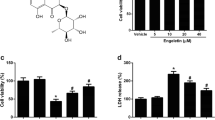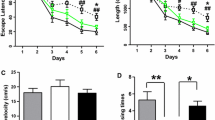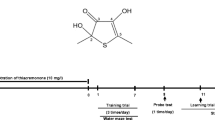Abstract
Alzheimer’s disease (AD) is a common neurodegenerative disease associated with deposition of β-amyloid peptide (Aβ). Platycodin D (PLD), a triterpenesaponin, may possess neuro-protective effect. In the current study, we aimed to explore the effects of PLD on Aβ-induced inflammation and oxidative stress in microglial BV-2 cells. Our study showed that PLD treatment improved cell viability in Aβ-induced BV-2 cells. PLD attenuated Aβ-induced inflammation with deceased production of TNF-α, IL-1β and IL-6 in Aβ-induced BV-2 cells. PLD also mitigated the oxidative stress in Aβ-induced BV-2 cells, as evidenced by deceased production of ROS and MDA, and increased SOD activity. Furthermore, the increased expression levels of TLR4 and p-p65 and decreased IκBα expression in the Aβ-stimulated BV-2 cells were attenuated by PLD treatment. Overexpression of TLR4 reversed the anti-inflammatory effect of PLD in Aβ-stimulated BV-2 cells. In addition, PLD treatment enhanced the Aβ-stimulated increase in the expression levels of Nrf2, HO-1, and NQO1 in BV-2 cells. Knockdown of Nrf2 abrogated the anti-oxidative effect of PLD in Aβ-stimulated BV-2 cells. In conclusion, these findings indicated that PLD protected BV-2 cells from Aβ-induced oxidative stress and inflammation via regulating the TLR4/NF-κB and Nrf2/HO-1 signaling pathways. Thus, PLD may be a potential candidate for the treatment of AD.







Similar content being viewed by others
Data Availability
The data that support the findings of this study are available from the corresponding author upon reasonable request.
References
Lane CA, Hardy J, Schott JM (2018) Alzheimer’s disease. Eur J Neurol 25:59–70
Bondi MW, Edmonds EC, Salmon DP (2017) Alzheimer’s disease: past, present, and future. J Int Neuropsychol Soc 23:818–831
Weller J, Budson A (2018) Current understanding of Alzheimer’s disease diagnosis and treatment. F1000Res 7:F1000
Selkoe DJ (2001) Alzheimer’s disease: genes, proteins, and therapy. Physiol Rev 81:741–766
Rozemuller JM, van der Valk P, Eikelenboom P (1992) Activated microglia and cerebral amyloid deposits in Alzheimer’s disease. Res Immunol 143:646–649
Cai Z, Hussain MD, Yan LJ (2014) Microglia, neuroinflammation, and beta-amyloid protein in Alzheimer’s disease. Int J Neurosci 124:307–321
Gouras GK, Olsson TT, Hansson O (2015) Beta-amyloid peptides and amyloid plaques in Alzheimer’s disease. Neurotherapeutics 12:3–11
Kozlov S, Afonin A, Evsyukov I, Bondarenko A (2017) Alzheimer’s disease: as it was in the beginning. Rev Neurosci 28:825–843
Wang G, Guo H, Wang X (2019) Platycodin D protects cortical neurons against oxygen-glucose deprivation/reperfusion in neonatal hypoxic-ischemic encephalopathy. J Cell Biochem 120:14028–14034
Park JC, Lee YJ, Choi HY, Shin YK, Kim JD, Ku SK (2014) In vivo and in vitro antitumor effects of platycodin d, a saponin purified from platycodi radix on the h520 lung cancer cell. Evid Based Complement Alternat Med 2014:478653
Qu Y, Zhou L, Wang C (2016) Effects of platycodin D on IL-1beta-induced inflammatory response in human osteoarthritis chondrocytes. Int Immunopharmacol 40:474–479
Choi JH, Yoo KY, Park OK, Lee CH, Won MH, Hwang IK, Ryu SY, Kim YS, Yi JS, Bae YS, Kang IJ (2009) Platycodin D and 2’’-O-acetyl-polygalacin D2 isolated from Platycodon grandiflorum protect ischemia/reperfusion injury in the gerbil hippocampus. Brain Res 1279:197–208
Gao W, Guo Y, Yang H (2017) Platycodin D protects against cigarette smoke-induced lung inflammation in mice. Int Immunopharmacol 47:53–58
Li W, Liu Y, Wang Z, Han Y, Tian YH, Zhang GS, Sun YS, Wang YP (2015) Platycodin D isolated from the aerial parts of Platycodon grandiflorum protects alcohol-induced liver injury in mice. Food Funct 6:1418–1427
Fu Y, Xin Z, Liu B, Wang J, Wang J, Zhang X, Wang Y, Li F (2017) Platycodin D inhibits inflammatory response in LPS-stimulated primary rat microglia cells through activating LXRalpha-ABCA1 signaling pathway. Front Immunol 8:1929
Sun F, Liu F (2020) Platycodin D inhibits MPP(+)-induced inflammatory response in BV-2 cells through the TLR4/MyD88/NF-kappaB signaling pathway. J Recept Signal Transduct Res 40:479–485
Song C, Mitter SK, Qi X, Beli E, Rao HV, Ding J, Ip CS, Gu H, Akin D, Dunn WA Jr, Bowes Rickman C, Lewin AS, Grant MB, Boulton ME (2017) Oxidative stress-mediated NFkappaB phosphorylation upregulates p62/SQSTM1 and promotes retinal pigmented epithelial cell survival through increased autophagy. PLoS ONE 12:e0171940
He FQ, Qiu BY, Zhang XH, Li TK, Xie Q, Cui DJ, Huang XL, Gan HT (2011) Tetrandrine attenuates spatial memory impairment and hippocampal neuroinflammation via inhibiting NF-κB activation in a rat model of Alzheimer’s disease induced by amyloid-β(1–42). Brain Res 1384:89–96
Wang Y, Che J, Zhao H, Tang J, Shi G (2018) Platycodin D inhibits oxidative stress and apoptosis in H9c2 cardiomyocytes following hypoxia/reoxygenation injury. Biochem Biophys Res Commun 503:3219–3224
Park BS, Lee JO (2013) Recognition of lipopolysaccharide pattern by TLR4 complexes. Exp Mol Med 45:e66
Hu X, Yu Y, Eugene Chin Y, Xia Q (2013) The role of acetylation in TLR4-mediated innate immune responses. Immunol Cell Biol 91:611–614
Mitchell S, Vargas J, Hoffmann A (2016) Signaling via the NFkappaB system. Wiley Interdiscip Rev Syst Biol Med 8:227–241
Huang NQ, Jin H, Zhou SY, Shi JS, Jin F (2017) TLR4 is a link between diabetes and Alzheimer’s disease. Behav Brain Res 316:234–244
Wu D, Zhang X, Zhao M, Zhou AL (2015) The role of the TLR4/NF-kappaB signaling pathway in Abeta accumulation in primary hippocampal neurons. Sheng Li Xue Bao 67:319–328
Ikram M, Muhammad T, Rehman SU, Khan A, Jo MG, Ali T, Kim MO (2019) Hesperetin confers neuroprotection by regulating Nrf2/TLR4/NF-kappaB signaling in an abeta mouse model. Mol Neurobiol 56:6293–6309
Jin X, Liu MY, Zhang DF, Zhong X, Du K, Qian P, Yao WF, Gao H, Wei MJ (2019) Baicalin mitigates cognitive impairment and protects neurons from microglia-mediated neuroinflammation via suppressing NLRP3 inflammasomes and TLR4/NF-kappaB signaling pathway. CNS Neurosci Ther 25:575–590
Song D, Jiang X, Liu Y, Sun Y, Cao S, Zhang Z (2018) Asiaticoside attenuates cell growth inhibition and apoptosis induced by abeta1–42 via inhibiting the TLR4/NF-kappaB signaling pathway in human brain microvascular endothelial cells. Front Pharmacol 9:28
Wu JT, Yang GW, Qi CH, Zhou L, Hu JG, Wang MS (2016) Anti-inflammatory activity of platycodin D on alcohol-induced fatty liver rats via TLR4-MYD88-NF-kappaB SIGNAL PATH. Afr J Tradit Complement Altern Med 13:176–183
Tonelli C, Chio IIC, Tuveson DA (2018) Transcriptional regulation by Nrf2. Antioxid Redox Signal 29:1727–1745
Bellezza I, Giambanco I, Minelli A, Donato R (1865) Nrf2-Keap1 signaling in oxidative and reductive stress. Biochim Biophys Acta Mol Cell Res 2018:721–733
Kerr F, Sofola-Adesakin O, Ivanov DK, Gatliff J, Gomez Perez-Nievas B, Bertrand HC, Martinez P, Callard R, Snoeren I, Cocheme HM, Adcott J, Khericha M, Castillo-Quan JI, Wells G, Noble W, Thornton J, Partridge L (2017) Direct Keap1-Nrf2 disruption as a potential therapeutic target for Alzheimer’s disease. PLoS Genet 13:e1006593
Bahn G, Jo DG (2019) Therapeutic approaches to Alzheimer’s disease through modulation of NRF2. Neuromol Med 21:1–11
Choi JH, Jin SW, Han EH, Park BH, Kim HG, Khanal T, Hwang YP, Do MT, Lee HS, Chung YC, Kim HS, Jeong TC, Jeong HG (2014) Platycodon grandiflorum root-derived saponins attenuate atopic dermatitis-like skin lesions via suppression of NF-kappaB and STAT1 and activation of Nrf2/ARE-mediated heme oxygenase-1. Phytomedicine 21:1053–1061
Author information
Authors and Affiliations
Corresponding author
Additional information
Publisher's Note
Springer Nature remains neutral with regard to jurisdictional claims in published maps and institutional affiliations.
Rights and permissions
About this article
Cite this article
Zhang, J., Song, N., Liu, Y. et al. Platycodin D Inhibits β-Amyloid-Induced Inflammation and Oxidative Stress in BV-2 Cells Via Suppressing TLR4/NF-κB Signaling Pathway and Activating Nrf2/HO-1 Signaling Pathway. Neurochem Res 46, 638–647 (2021). https://doi.org/10.1007/s11064-020-03198-6
Received:
Revised:
Accepted:
Published:
Issue Date:
DOI: https://doi.org/10.1007/s11064-020-03198-6




